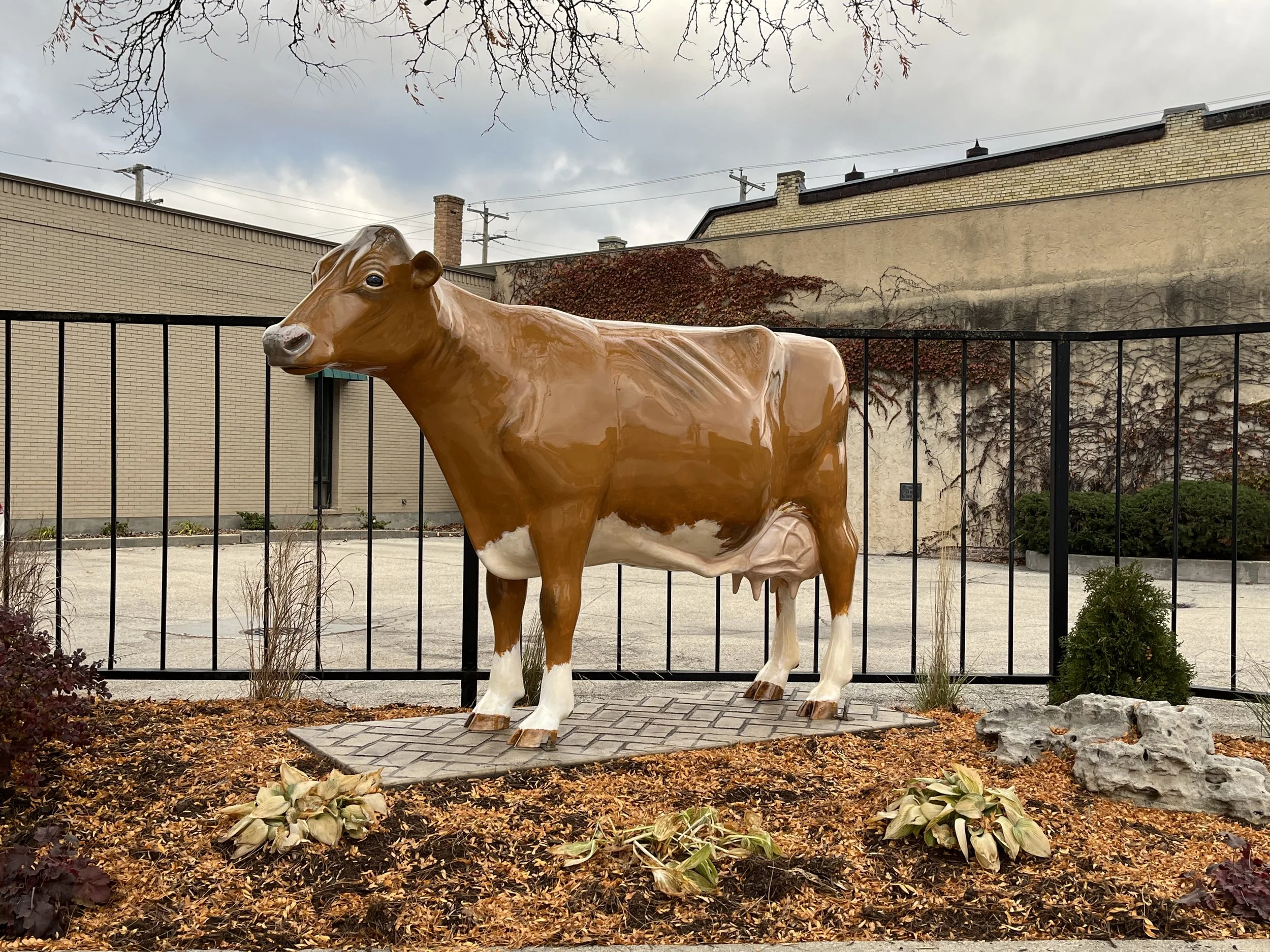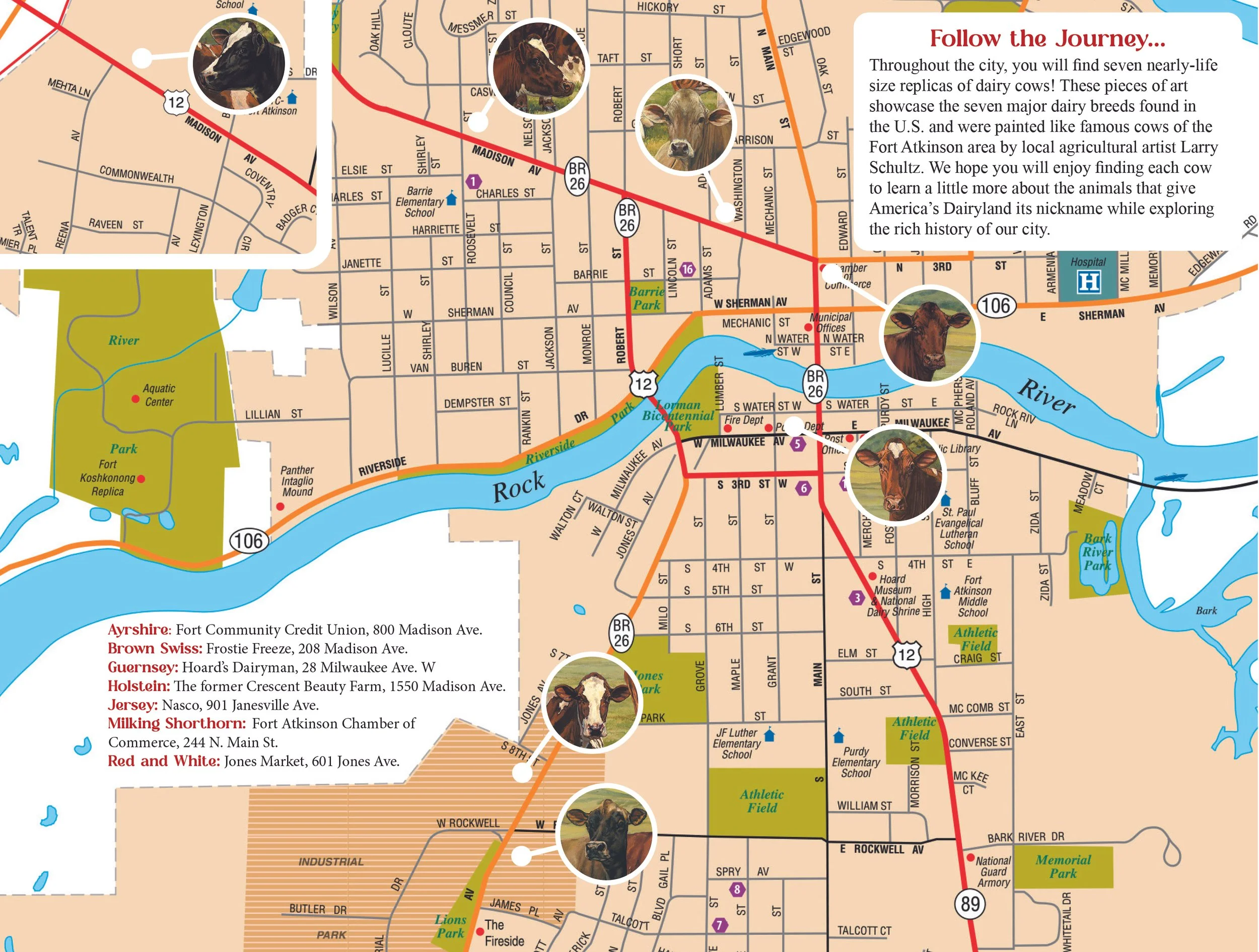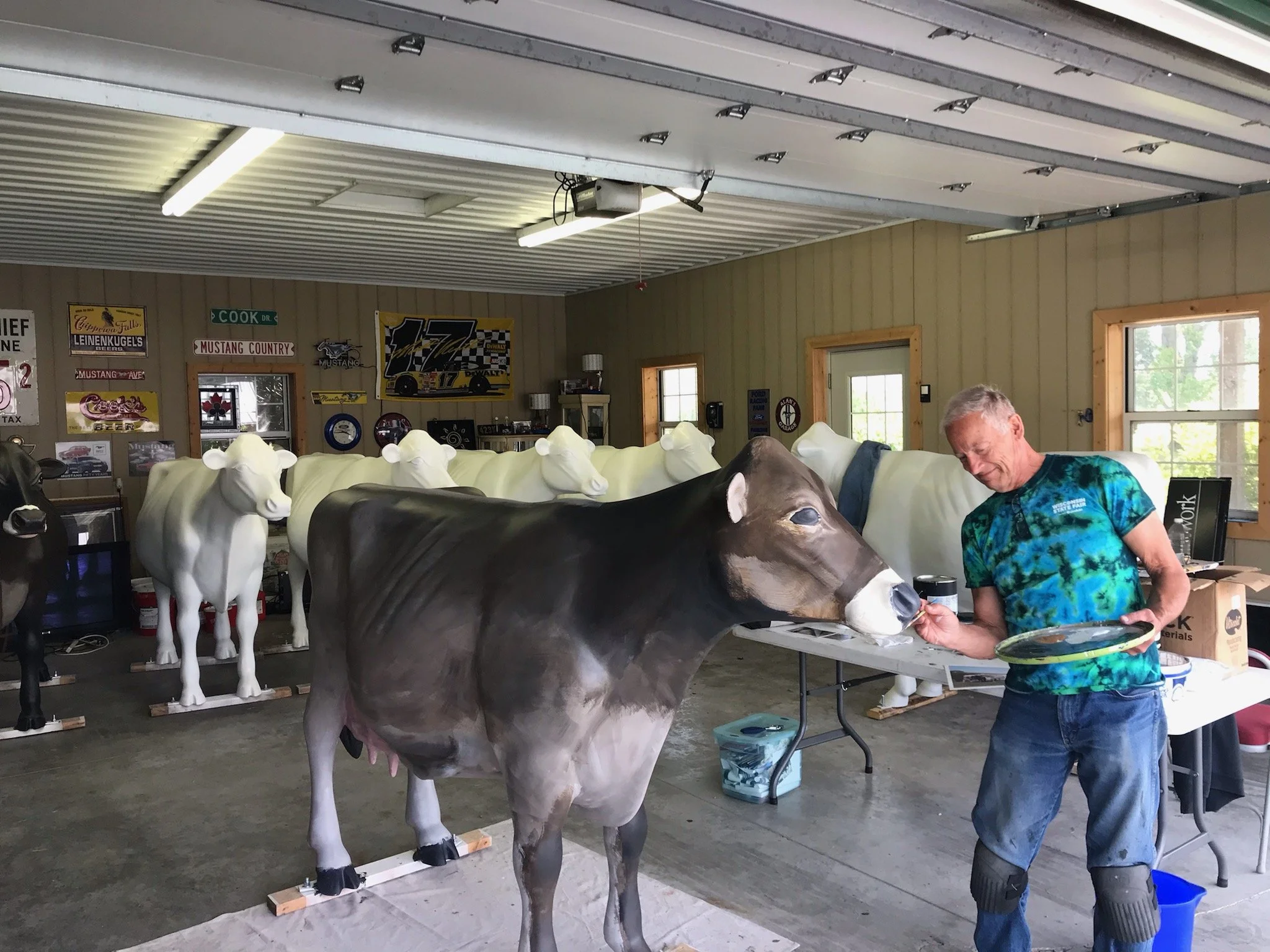
A Rich Dairy Cattle Heritage in Fort Atkinson, Wisconsin
The Fort Atkinson Cow Parade
Several generations ago at the Jefferson County Fair, it was a tradition for dairy exhibitors to parade their cattle on the race track in front of the crowd sitting in the long wooden grandstand on Sunday. It was the last day of the fair, a time to celebrate your accomplishments and begin to forget your disappointments.
A parade of seven multicolored dairy cows through the streets of Fort Atkinson celebrates a legacy of historic excellence. It is meaningful and appropriate because there is no city with Fort Atkinson’s dairy heritage anywhere else in the world.
Click on a cow to learn more about the inspiration for each one.
Thank you to these generous sponsors for making this project possible!
Supreme Champion
Fort Atkinson Community Foundation (Ayrshire replica)
Sunshine Genetics (Brown Swiss replica)
Brain and Terrie Knox (Guernsey replica)
Crescent Beauty Farm, Hetts families (Holstein replica)
Pete’s Tire Service (Jersey replica)
Fort Atkinson Chamber of Commerce (Milking Shorthorn replica)
Lundy Farms (Red and White replica)
Grand Champion
Beane and Baird Families
Kramer Enterprises
Intermediate Champion
Gerber Grain Farms, Jeff and Monica Gerner
Robert and Jeanne Bell
Fort Community Credit Union
John and Vicki Meyer
Nancy Hoard Glenn
Junior Champion
Frostie Freeze
Fort Atkinson Generals
Jude and Sue Hartwick
Holstein Association USA
Marilyn Frey
Rocky Lane Farm, Cook Family
Rosette
Mapleton Valley Farm, Phyllis Agnew
Ozinga Concrete
Roger and Marsha Anderson
Pete and Linda Draeger
Bill and Karen Stade
Blue Ribbon
Hoard Historical Museum
Earl and Judith Reu
Ron and Sue Dahnert
Dean and Sandy Yandry
LuAnn Preuninger
Allen “Butch” and Chris Lemke
Ryan, Shawna, and Anna Butz
Fort Atkinson’s Dairy History
In 1832, Milo Jones, a government surveyor, moved from Vermont to what is now Fort Atkinson with his wife, Sally Crane Jones, and their two children to establish a dairy farm. This small family farm made cheese and butter, and they also raised pigs for their own consumption.
Fort Atkinson played an important role in developing Wisconsin as the cheesemaking capital of the U.S. It is believed that the state’s first farmstead cheese factory opened in Koshkonong around 1831. Additionally, the Wisconsin Historical Society cites Charles Rockwell as one of the state's earliest cheesemakers. He was one of the area's first settlers and is reported to have been making cheese as early as 1837, near Koshkonong. A talented carpenter, Rockwell later put his skills to use building, among other landmarks in town, Fort Atkinson's first store on Main Street. His legacy is honored at Rockwell Elementary School.
By 1857, American dairy farmers began to import Holstein cattle from Holland. The Holstein Friesian Association of America was founded in Brattleboro, Vermont, in 1885.
Red and White Holsteins are genetically the same as their black and white counterparts, with the exception of having two recessive genes for coat color. Holsteins are easily the most common dairy breed in the world, found in 150 countries. They also make up about 90% of the dairy cattle in the U.S. This is largely because Holsteins are the highest-producing dairy breed.
Guernsey cattle came to the U.S. from the English Channel Isle of Guernsey, and Jersey cattle were imported from the English Channel Island of Jersey. Brown Swiss cattle originated in the Swiss Alps. Milking Shorthorns came from England, and Ayrshires are a Scottish breed of dairy cattle. All seven breeds have their own strengths and weaknesses depending on climate, altitude, purpose, and uses of their milk.
In 1872, William Dempster Hoard, who moved to Fort Atkinson from New York after the Civil War, was among the men who organized the Wisconsin Dairyman’s Association with the goal of improving and promoting dairy products. In 1877, the American Guernsey Cattle Club was founded in Peterborough, New Hampshire. Hoard and his son, Bill, were great promoters of the Guernsey breed. Since 1950, “Golden Guernsey” milk has been sold as a premium product in the U.S. and Canada. Guernsey milk has a golden color due to higher levels of the pigment beta carotene. The body converts beta carotene into vitamin A (retinol), which is important for vision and keeping vital organs like heart, lungs, and kidneys healthy. Guernsey milk also has a higher percentage of butterfat and protein than Holstein milk. Jerseys also have high components and are smaller, very efficient, and tolerate hot weather better than Holsteins. Brown Swiss cattle are the best choice for mountainous countries.
Hoard’s Dairyman magazine was founded in Fort Atkinson in 1885. W.D. Hoard believed growing alfalfa and feeding it to dairy cows would help the state’s struggling wheat farmers earn a more reliable income, so he advocated for dairy farming in his daily newspaper, the Jefferson County Union. The dairy section became so popular that it eventually became a standalone magazine.
Still today, Hoard’s Dairyman is arguably the leading dairy publication in the world. Dairy producers rely on articles about nutrition, genetics, health, cow comfort, business, dairy legislation, manure management, milk marketing, and more penned by highly respected authors. Hoard’s Dairyman is continuing education for those competing for a piece of the dairy market.
In 1888, Hoard ran for and was elected the 16th governor of Wisconsin. During his tenure, the college of agriculture was established at the University of Wisconsin.
In 1899, Hoard purchased 193 acres outside of town and established a dairy farm to practice and implement the strategies discussed in the magazine. Guernseys formed the foundation of the herd, and today, the farm has the longest continuously registered herd of Guernseys in North America.
The Hoard’s Dairyman Cow Judging Contest began in 1930 and has tracked the incredible progress of type conformation that has allowed U.S. cows to produce increasingly high amounts of milk.
In 1912, W.D. James founded the James Way Manufacturing Company in Fort Atkinson. Earlier, James had invented the first adjustable cow stall with a swivel stanchion in a blacksmith shop. As very small herds grew larger, James’ forged steel barn cleaners, drinking cups, stanchions, tie stalls, box stalls, bulk tanks, and silo unloaders helped dairy farmers become more efficient and gave their families a better quality of life. The Creamery Package Company opened in 1920 and made equipment for creameries, cheese factories, dairies, and ice cream plants.
In 1922, James built a state of the art dairy barn on 80 acres of land that he had purchased from the Jones family. Four men worked on the property that produced fresh Guernsey milk and eggs to be delivered to homes in Fort Atkinson. “Kleen Milk” was their brand name. The Jones family bought back the barn and land after the James’ death. In 2022, a celebration of 100 years of the “Jones Yellow Barn” took place.
Nasco opened in Fort Atkinson in 1941. By the 1960s, its farm and home store was a place where dairy producers could fill their needs for just about any item imaginable. Its catalog business exploded. Arthur Nesbitt, a proud Penn State graduate, came to Nasco from the Pennsylvania Holstein Association and served as Nasco’s CEO for decades. He became a dairy industry leader and helped World Dairy Expo grow and prosper in its first 50 years.
In 1949, Allen Hetts showed Crescent Beauty Lady Gloria, a 3-year-old Holstein, to Grand Champion Female at the National Dairy Cattle Congress in Waterloo, Iowa. He rang the bell a second time with Da-co-ton Crescent Fannie, an aged cow, who won the title in 1958.
When Hetts sensed that show management was slipping, he set out on a mission to replace the show with one in Madison, Wisconsin, and became one of the founders of the prestigious World Dairy Expo. Hetts was recognized by his peers as being one of the best showmen and fitters in the country when he won the Klussendorf trophy in 1970. These skills are the reason Gene Acres Farm manager Ray Potter sold him Gene Acres Felicia May Fury as a 3-year-old. Potter knew that Hetts would get her to the right shows and give her the best chance to win. She had a long, successful run before she was named Supreme Champion at the 1974 World Dairy Expo for her new owners, Felicia May Associates.
By the 1950s, there were dozens of dairy herds with Fort Atkinson addresses that consisted of all seven breeds. Health Way Dairy provided milk from local producers to the school district. Students could buy a small bottle of white or chocolate milk for two cents.
Perhaps the finest Holstein ever born and bred in the Fort Atkinson countryside was Future Hope Reflector Blacky. Harold and Lucile Draeger had seven children: Donna, Roger, Ralph, Andrea, Marilyn, Peter, and Pamela. Roger showed Blacky, Marilyn served Wisconsin as the 16th Alice in Dairyland, and Peter took over the dairy farm in 1972. Peter’s son Karson and his family now manage the fourth- generation farm with the assistance of Ralph’s son Luke. Using Crescent Beauty breeding as the foundation, Harold made the now legendary Burke/Rag Apple mating that not only produced the Blacky cow family but also earned Future Hope Farm the first ever Progressive Breeder Registry award given in Jefferson County. In July 1965, Blacky and her stablemate Future Hope Faith Esther were named Grand Champion and Reserve Grand Champion at the Wisconsin State Black & White Show. Blacky won the 4-year-old class at the National Dairy Cattle Congress in Waterloo, Iowa. Tara Hills Farm of New York and Brigeen Farm of Maine purchased Blacky and her daughter Future Hope Rocket Flicka from the Draegers. Flicka later classified the maximum score of Excellent 97 points. Blacky later sold for a world record $125,000 at the 1974 Shore Canadian Classic Sale. Blacky’s legacy is that her genetic contributions improved many herds throughout North America.
The herd of Guernseys at Jones Dairy Farm was replaced by registered Holsteins in 1974, and the stalls were reconstructed for larger cows. The Holsteins were high milk producers, and in 1980, a Jones-bred consignment to the Kentucky Blue Grass Classic, J-D-F Ivy Una, topped the sale with a bid of $6,100.
The list of national dairy leaders who have resided in or around Fort Atkinson is remarkable. The big three at Hoard’s Dairyman were publisher William Knox, managing editor Eugene Meyer, and art director James Baird, who served the dairy industry for a combined 183 years.
Craig Beane was one of the founders of the national Dairy Herd Improvement Association and a longtime contributor to the Wisconsin Agriculturist magazine, fielding questions on dairy herd management, expanding facilities, and milk marketing. Craig and Tom Beane’s HOL-WIS Farms co-hosted the 1956 Farm Progress Days with Bill and Ted Ward’s Ward-land Farm.
Just around the bend from the Beanes is the Guernsey family farm where Richard Erdman grew up. Dr. Erdman became chairman of the animal science department at the University of Maryland and later served as president of the American Dairy Science Association.
Bill Maynard was executive secretary of the American Guernsey Cattle Club before moving his family to Fort Atkinson to join the Hoard’s Dairyman advertising team. He later served as president of National Dairy Shrine.
Leslie Peckham was the longtime fieldman for the American Guernsey Cattle Club.
Born and raised in Fort Atkinson, John Meyer learned business from Art Nesbitt at Nasco before becoming executive secretary of the National Brown Swiss Association. In 2001, John was hired as CEO of Holstein Association USA, formerly the Holstein Friesian Association of America. The breed association was losing $2 million a year at that time, but by making difficult cuts and using a sound business plan, Meyer’s team reversed the trend.
The National Dairy Shrine became part of the Hoard’s Historical Museum in 1980. It attracts hundreds of visitors annually. The National Dairy Shrine tells the story of dairying in America through generations. It honors dairy pioneers, great leaders, breeders, cows, and bulls. The Shrine displays trophies and plaques of the national winning 4-H and collegiate dairy judging teams. Plaques for World Dairy Expo’s top showmen, fitters and grand champions are displayed under glass. National Dairy Shrine also sponsors scholarships for top students intending to follow careers in the dairy industry.
Today, Hoard’s Dairyman magazine has readers around the world.
At the Hoard’s Dairyman Farm, about 300 cows are milked, most of which are still Guernseys. While some are milked in a parlor constructed in 2007, most cows live in a barn containing automatic milking systems, or robots. A cow voluntarily walks to the robot when the pressure on her udder tells her it is time to be milked and the computer system is able to easily milk her with no human labor required. All of the cows lay on large free stalls that are bedded with sand. Cow comfort, as well as nutrition, genetics, and manure management, are all high priorities.
The landscape of dairy farms near our city and beyond has certainly changed. There are still some small, quality herds in tie stall barns. Larger herds in free-stall barns are more common. Tall upright silos are disappearing from the skyline in favor of long plastic bags, large bales, and bunkers. Cows are eating total mixed rations where every bite is perfectly balanced with exactly the nutrients the cows need.
Milo Jones pioneered dairy farming in the Wisconsin Territory in 1832. One can only imagine the courage that took. Today’s dairy farmers feel heavy debt loads and see razor thin profit margins. It is not for the faint hearted.















